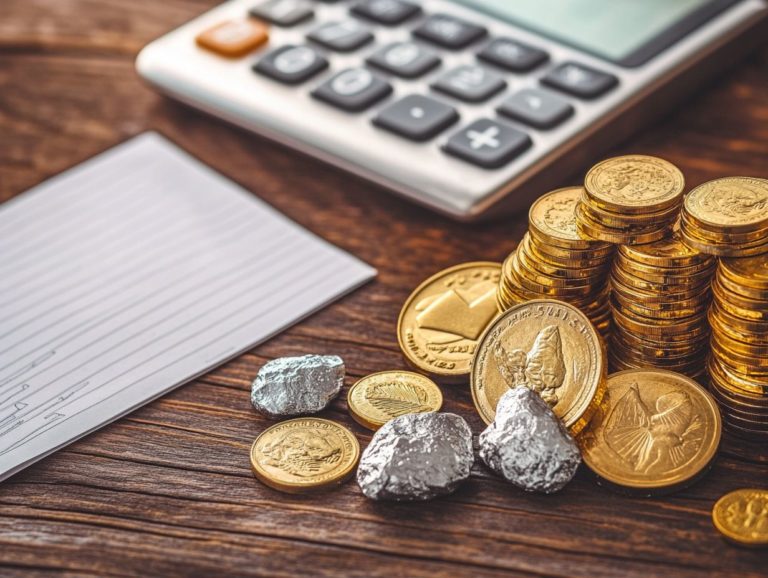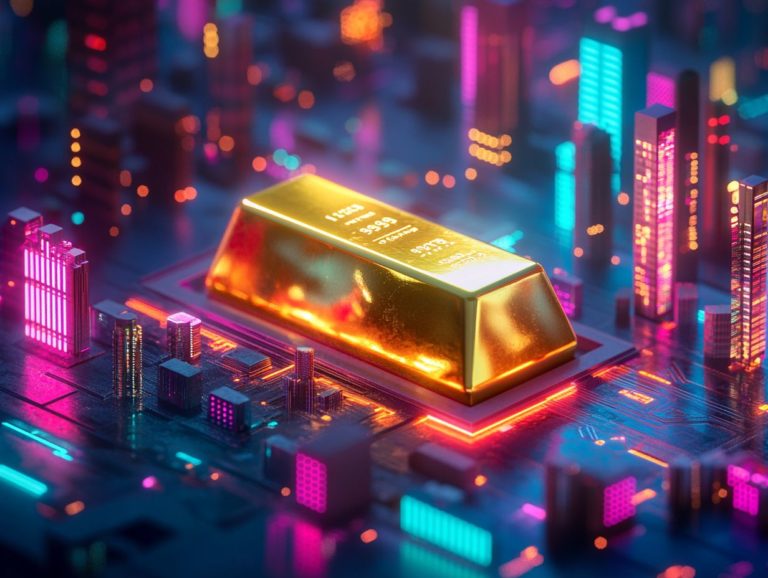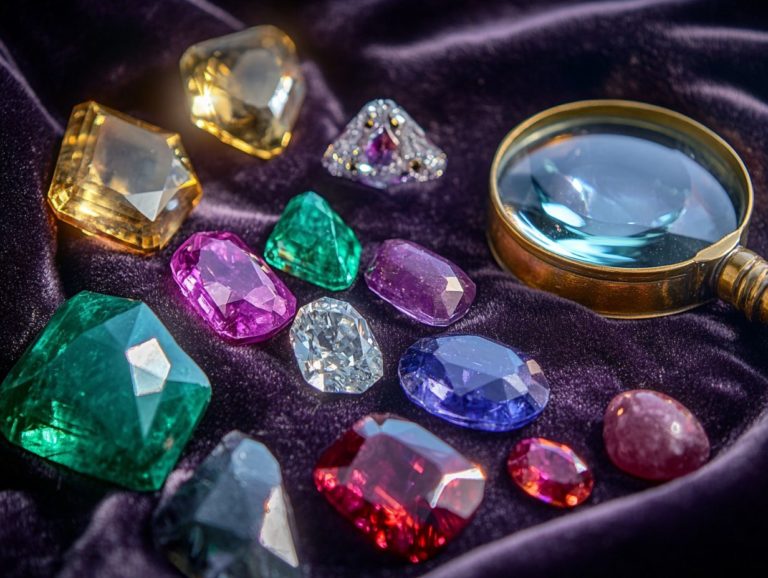Understanding the Role of Precious Metals in Diversification
In today s unpredictable financial landscape, diversification stands as a cornerstone of effective investing. By allocating your assets across various categories, you can significantly reduce risk and enhance your potential returns.
Let s explore the concept of diversification, highlighting its benefits and examining the vital role precious metals play in a well-rounded investment strategy.
From gold and silver to platinum and palladium, you ll discover how these assets can fortify your portfolio. We ll also discuss essential factors to consider when investing in them.
Contents
- Key Takeaways:
- The Importance of Diversification in Investing
- The Role of Precious Metals in Diversification
- Types of Precious Metals to Consider
- Factors to Consider When Investing in Precious Metals
- Frequently Asked Questions
- What is diversification and how do precious metals play a role in it?
- What are the different types of precious metals that can be used for diversification?
- Can investing in precious metals help protect against inflation?
- What are the risks associated with investing in precious metals for diversification?
- Are there any tax implications to consider when investing in precious metals for diversification?
- Can I physically own precious metals when using them for diversification?
Key Takeaways:
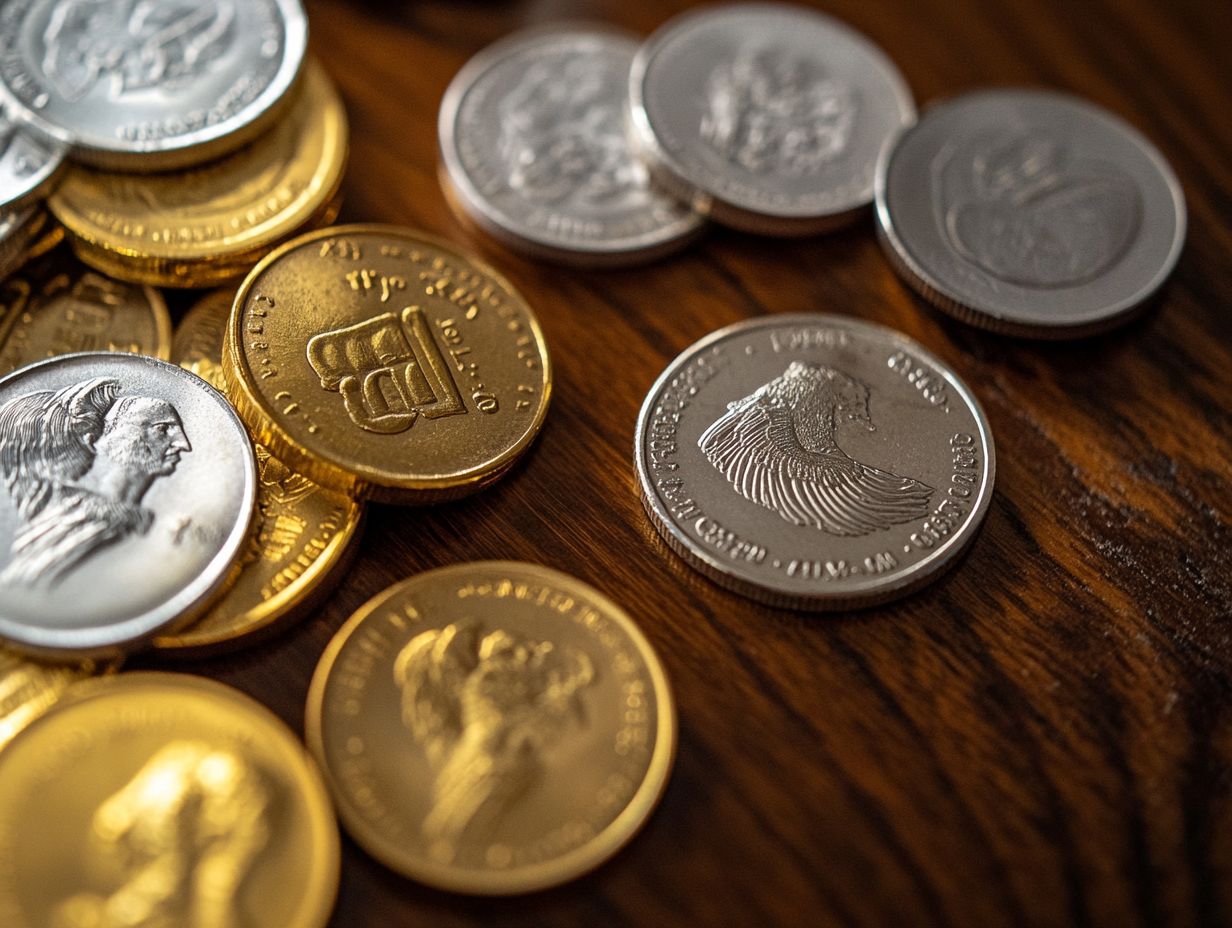
- Diversification is essential in investing to reduce risk and increase potential returns.
- Precious metals, such as gold and silver, can play a crucial role in diversifying your investment portfolio.
- When considering investing in precious metals, factors such as market trends, prices, and storage should be carefully evaluated.
The Importance of Diversification in Investing
Diversification is an essential investment strategy that entails spreading your capital across various asset classes to reduce risk while enhancing the potential for returns.
By diversifying your investment portfolio, you can effectively mitigate the impact of market volatility and economic uncertainty. This ensures your asset allocation remains resilient during market downturns and price fluctuations.
This approach allows for better risk management, helping you align your investments with your risk tolerance and achieve your long-term investment goals with confidence.
What is Diversification?
Diversification involves distributing your investments across different asset classes to minimize risk and maximize returns, a strategy that financial advisors often recommend.
By allocating your capital among diverse stocks, bonds, real estate, and even alternative investments, you can protect yourself from the volatility of any single asset. This multifaceted approach enhances your potential for stable, long-term growth.
For example, stocks can offer great returns during market booms, whereas bonds are typically safer during downturns.
The true art of diversification lies in choosing investments that are not closely related, ensuring that the performance of one asset class does not disproportionately affect your entire portfolio.
Therefore, integrating different investment approaches is essential. This balance allows you to manage risk effectively while seizing opportunities in various market conditions.
Benefits of Diversification
The benefits of diversification in investing are remarkable, offering everything from enhanced risk management to improved wealth preservation during financial turmoil and economic uncertainty.
By spreading your investments across a variety of asset classes such as stocks, bonds, and real estate you can significantly lower your risk exposure.
During an economic downturn, while stock prices may nosedive, bonds often provide a steady income. This balance can smooth out the overall performance of your investment portfolio.
Diversification also opens the door to different growth opportunities. Don t miss out on the chance to protect your wealth!
Ultimately, a well-diversified portfolio acts as a protective shield against market volatility, helping to safeguard your wealth from inflationary pressures and unexpected financial crises.
The Role of Precious Metals in Diversification
Precious metals, such as gold and silver, are essential components of your diversification strategy. They provide a reliable hedge against market volatility and economic uncertainty, significantly strengthening the resilience of your investment portfolio.
Why Invest in Precious Metals?
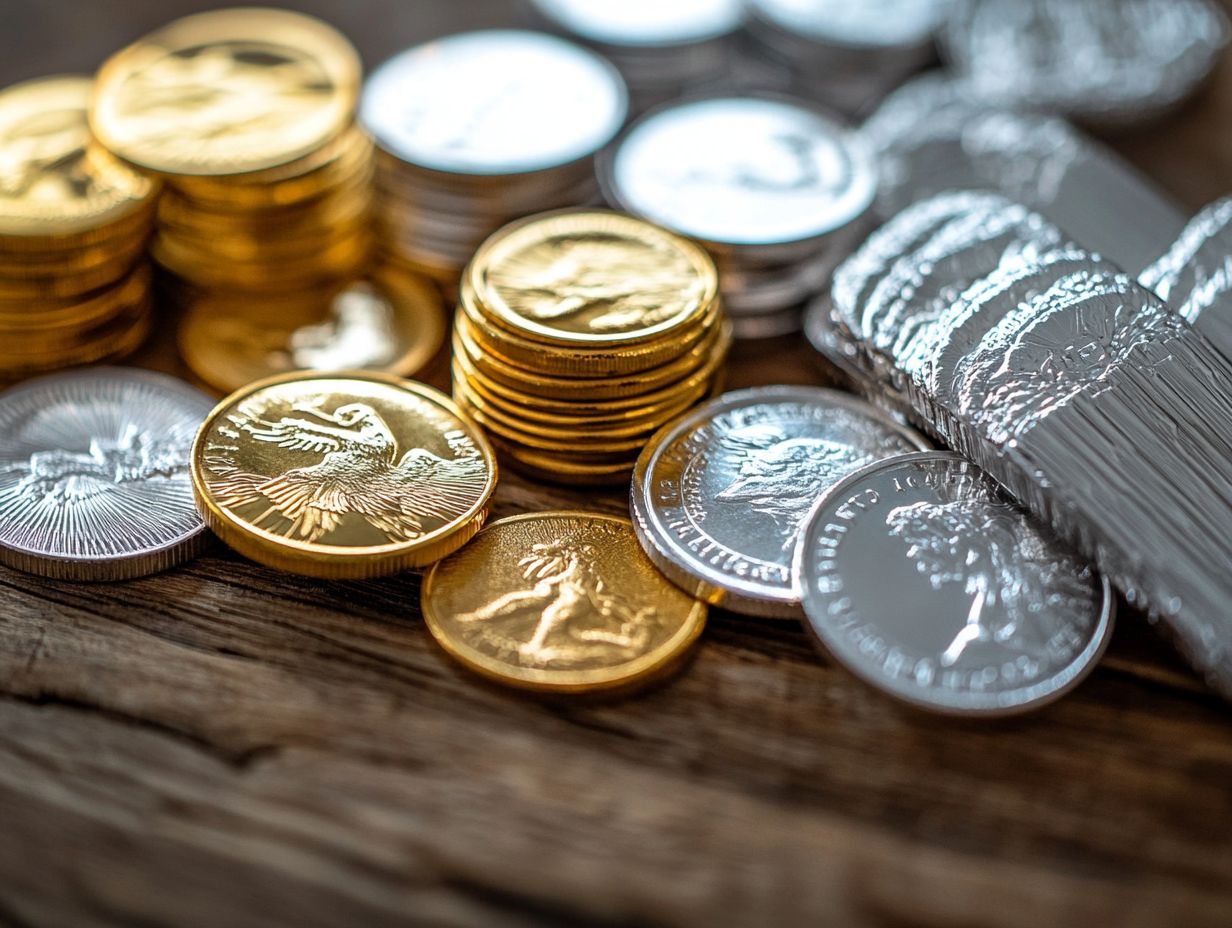
Investing in precious metals like gold and silver is a safe haven. They have intrinsic value and maintain purchasing power, especially during inflation and economic unrest.
Many studies show this is true, as these assets have preserved wealth while other investments stumble.
Remember the 1970s? Inflation was soaring, yet gold’s price skyrocketed from about $35 to nearly $850 per ounce. This remarkable rise illustrates its effectiveness as a hedge against currency devaluation.
Unlike stocks or bonds, which can suffer substantial losses, precious metals typically retain their value and often appreciate over the long haul.
Recent statistics show that gold has outperformed the S&P 500 over various extended periods, showcasing its reliability as an asset class that investors trust to protect their portfolios.
How Precious Metals Can Diversify Your Portfolio
Incorporating precious metals into your investment portfolio can significantly enhance your diversification strategy. They provide stability and reduce risk during market downturns.
When the stock market faces volatility or economic uncertainty, assets like gold and silver often retain their value or even appreciate, serving as your safe haven. During the 2008 financial crisis, for instance, gold prices soared as investors sought refuge from falling stocks.
In a thriving economy, palladium and platinum can become particularly appealing due to their industrial applications, contributing to your portfolio’s growth. By strategically allocating a portion of your investments to these metals, you can mitigate potential losses and position your portfolio favorably across varying market conditions.
Types of Precious Metals to Consider
When evaluating investment opportunities in precious metals, delve into the distinct types available, such as gold, silver, platinum, and palladium.
Each metal has unique characteristics and is influenced by specific market conditions. It’s crucial to understand their individual dynamics before making informed decisions.
Gold
Gold is often seen as the premier precious metal in investment portfolios, cherished for its historical track record as a safe haven during economic turmoil and currency fluctuations.
Throughout history, gold has adorned the crowns of monarchs and remained a symbol of wealth and stability during uncertain times.
You might notice its price fluctuating significantly, influenced by factors like geopolitical tensions and shifts in global demand. Today, market analysts emphasize diversifying with gold, especially in light of rising inflation and unpredictable stock markets.
Smart investors use strategies like dollar-cost averaging or investing in gold exchange-traded funds (ETFs) which allow you to buy shares of gold without holding physical metal to protect their wealth and hedge against economic downturns. This solidifies gold s enduring status as a cornerstone of financial stability.
Silver
Silver, often overshadowed by gold, is a remarkably versatile precious metal that serves dual roles as both an investment and an industrial commodity. This positions it uniquely amid market volatility.
Recent trends reveal a rising demand for silver, particularly in the renewable energy sector, where it plays a crucial role in solar panels and electric vehicles. This expanding industrial usage adds a fascinating layer to its investment allure.
Investors are increasingly recognizing silver as a viable hedge against economic uncertainty, especially with its price hovering around $24 per ounce a notable rebound from previous lows.
For those considering portfolio diversification, incorporating silver may not only help mitigate risk but also capture upside potential as market conditions shift. Incorporating silver could be your key to capitalizing on market changes!
Platinum

Platinum is a precious metal that captivates investors with its rarity and unique opportunities, especially in the ever-evolving landscape of market conditions and industrial applications.
This extraordinary metal is celebrated for its remarkable density and corrosion resistance. It’s not just a favorite in jewelry; it also holds significant importance across various industries, including automotive and electronics.
In the automotive industry, platinum is vital for catalytic converters. They help reduce harmful emissions.
Given the current market climate, driven by shifting demand and supply dynamics, there’s a promising indication that platinum prices may rise. Manufacturers are increasingly adopting cleaner technologies.
For you as an investor, adding platinum to your portfolio could provide valuable diversification. This is particularly beneficial during uncertain economic periods due to its unique performance patterns that often contrast with traditional assets like stocks or bonds.
Palladium
Palladium is a compelling investment. Its strong industrial demand and market trends are noteworthy.
This precious metal boasts unique attributes, particularly its ability to reduce harmful emissions in catalytic converters for gasoline engines.
Its applications have broadened to include electronics, dentistry, and even hydrogen storage technologies, showcasing its versatility and consistent demand trajectory.
As global economies increasingly prioritize green technologies and implement stricter emission regulations, palladium’s importance continues to grow.
For investors seeking diversification, there s a prime opportunity to leverage these trends! Palladium not only presents strong potential for price appreciation but also serves as a hedge against inflation and market volatility, enhancing a well-rounded investment strategy.
Factors to Consider When Investing in Precious Metals
Investing in precious metals requires attention to several key factors. These can significantly impact your strategy.
Pay attention to market trends and pricing fluctuations, as these will guide your purchasing decisions. Additionally, think about your storage solutions and security measures; safeguarding your assets is paramount.
Market Trends and Prices
Understanding market trends and prices is crucial for smart investment decisions. These factors directly affect your potential returns.
Recent fluctuations in gold, silver, and platinum prices reveal a complex landscape influenced by various global economic indicators. You should closely analyze historical performances over the past decade.
For instance, political instability, inflation rates, and currency strength have shaped valuations. Charts illustrating these patterns can provide clarity on the seasonal demand and supply dynamics that drive pricing.
Current economic forecasts suggest that while some volatility may linger, a bullish sentiment towards these metals could emerge, particularly if economic uncertainties continue to escalate.
Storage and Security
Effective storage and security measures are essential when investing in precious metals. They protect your investment portfolio from theft and damage.
Your storage choice impacts the safety and accessibility of your assets. Choose wisely! You have two primary paths: keeping your metals at home or opting for third-party vaults, each presenting its own set of advantages and potential drawbacks.
Home storage offers immediate access, but it raises concerns about physical security and the risk of theft. Third-party vaults come with expert handling and enhanced safety features.
As you navigate this decision, weigh factors like insurance coverage, local crime rates, and the possibility of unforeseen circumstances. Ultimately, your storage method should align seamlessly with your specific investment strategy and risk tolerance.
Frequently Asked Questions
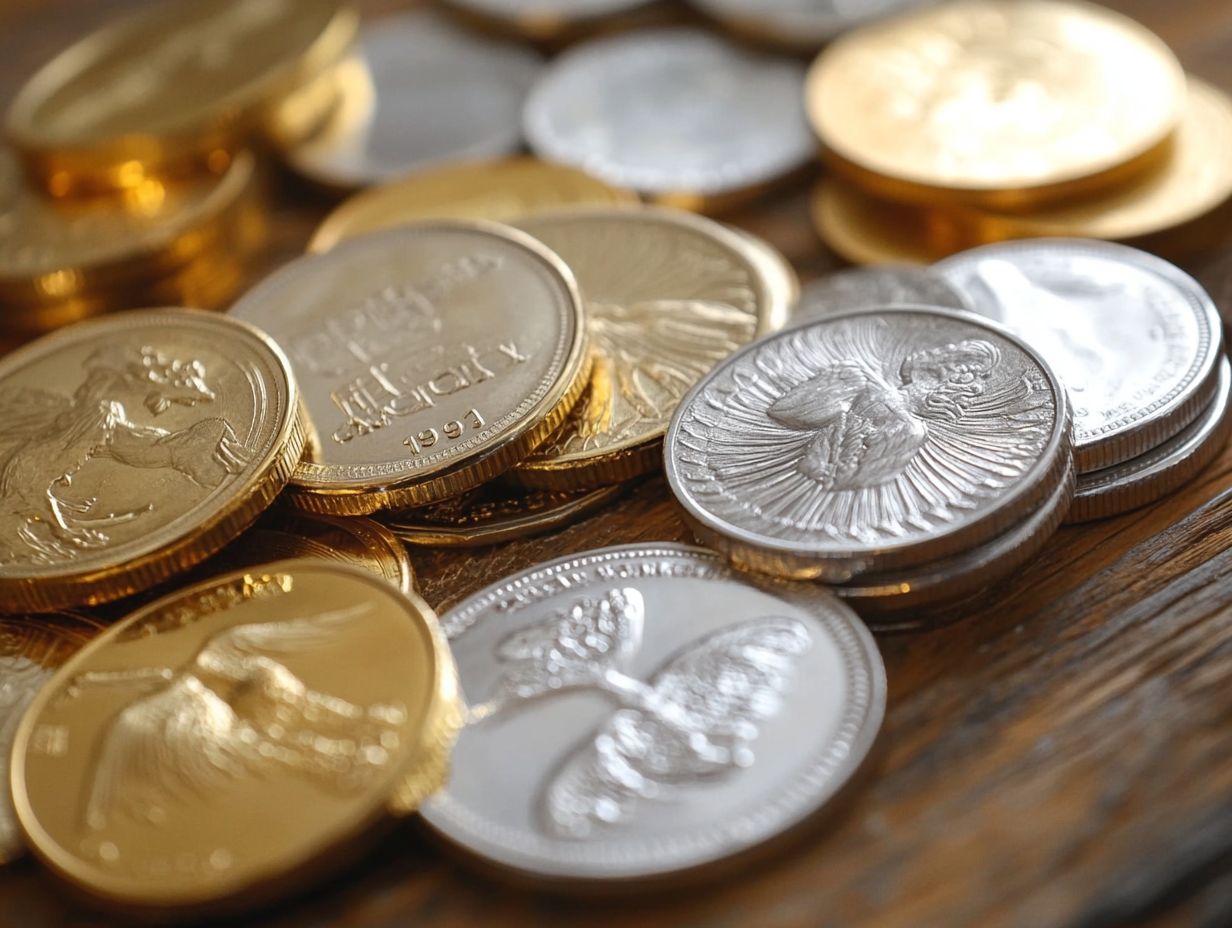
Investing in precious metals can be a wise decision. They offer diversification and protection against market volatility. Now is the perfect time to consider adding these valuable assets to your portfolio!
What is diversification and how do precious metals play a role in it?
Diversification means spreading your investments across various asset classes. This strategy helps reduce risk.
Precious metals, such as gold and silver, are key to diversification. They often have a low correlation with other assets, meaning their value does not necessarily move in the same direction as stocks or bonds.
What are the different types of precious metals that can be used for diversification?
The four main precious metals used for diversification are gold, silver, platinum, and palladium.
Each metal has its unique properties and offers different benefits to a diversified portfolio.
Can investing in precious metals help protect against inflation?
Absolutely! Investing in precious metals is a smart way to protect your money from inflation.
Historically, when inflation rises, precious metals often increase in value. People tend to buy them to protect their money.
What are the risks associated with investing in precious metals for diversification?
Like any investment, there are risks associated with investing in precious metals for diversification.
The value of these metals can be affected by market fluctuations, supply and demand, and geopolitical events.
It s crucial to conduct thorough research and talk to a financial advisor before investing.
Are there any tax implications to consider when investing in precious metals for diversification?
Yes, there may be tax implications when investing in precious metals.
For example, gains from the sale of precious metals may be subject to capital gains tax. Understanding these implications and consulting with a tax professional is essential before making any investment decisions.
Can I physically own precious metals when using them for diversification?
Yes, you can physically own precious metals when using them for diversification. Many investors choose to purchase physical gold or silver coins or bars as a way to diversify their portfolio.
However, there are also other ways to invest in precious metals, such as through exchange-traded funds (ETFs) or mutual funds.

